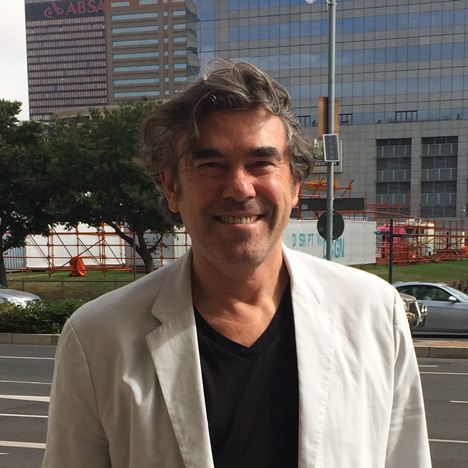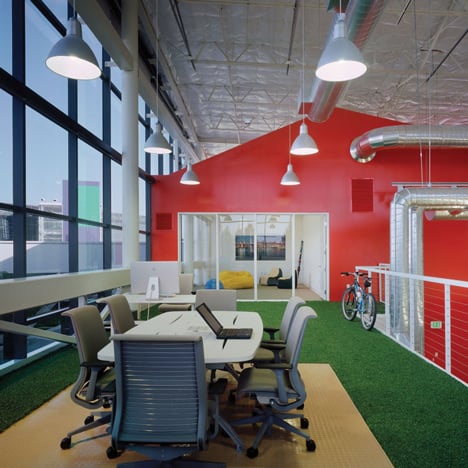
"Google was cubicle land when we started designing offices for them"

Interview: Clive Wilkinson, the architect behind the office design at Google's Silicon Valley headquarters, tells us how he convinced the internet giant to move away from "humiliating, disenfranchising and isolating" workers' cubicles (+ transcript).
Speaking to Dezeen during this year's Design Indaba event in Cape Town, Wilkinson recounted how he and his team had to persuade the tech company to switch from a typical cubicle layout to a more transparent workspace when the firm first worked on offices for Google in 2005.
"We had to do quite a bit of convincing to make the founders move away from their cubicle model," he said. "We managed to turn all of their enclosed rooms into glass rooms."
Google now commissions bespoke designs for each of its outposts around the world, such as its Tel Aviv office full of orange trees and its London headquarters that features balcony gardens and allotments.
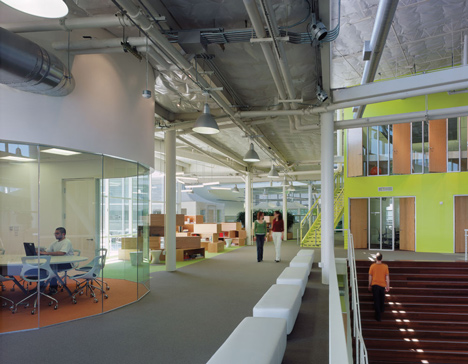
Wilkinson said that California is still home to the most exciting office interiors right now, because tech companies like Apple, Twitter and Airbnb are "phenomenally rich", but that there's still room for more workspace innovation there.
"The San Francisco and Silicon Valley area of America is a massive test bed of new working but it's not completely radical yet," he said.
However, Wilkinson believes that more American companies need to catch on to the way these firms design their workspaces, as the majority of them are still using the cubicle offices he detests.
"I'd say 75 to 80 percent of America is cubicle land," he said. "Cubicles are the worst - like chicken farming. They are humiliating, disenfranchising and isolating. So many American corporations still have them."
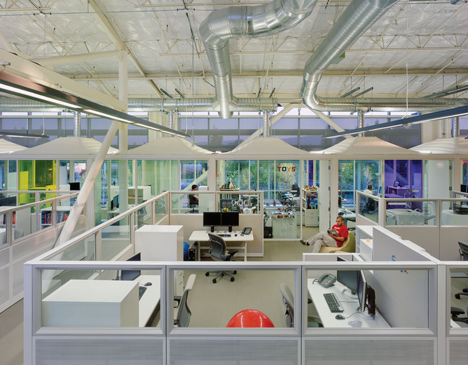
He contrasts these American firms with Australian corporations, like the Macquarie investment bank he designed the One Shelley Street offices in Sydney for in 2009. He claims their smaller size makes them more conscious about the quality of workspaces for employees.
"American businesses are very conservative and issues of real estate don't tend to get the attention of the CEO," Wilkinson explained. "Conversely in Australia, where corporations are not that big, real estate does get the attention of the CEOs. They are mindful of the massive impact that an environment can have on productivity and effectiveness of the company and are prepared to take it pretty seriously."
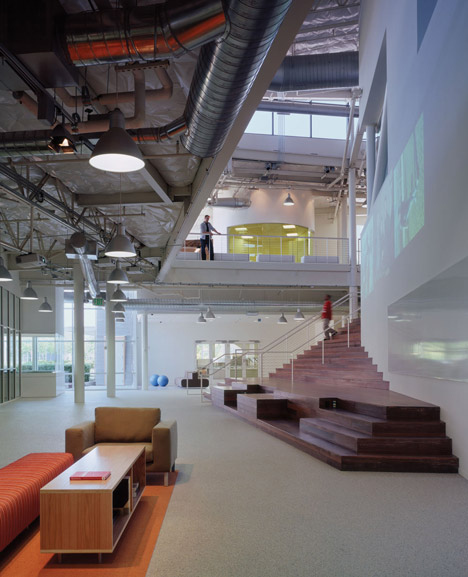
Wilkinson said that he enjoys designing interiors because they have more effect on the users than a building's exterior.
"In our design practice we are fundamentally trying to address psychological issues," Wilkinson told Dezeen. "One of the reasons I really like workplaces and interiors is that the impact on humanity is much more powerful than dealing with inert architectural shells, or the decorative outside dress of a building - which frankly is what most architects do."

He went on to describe the current rift between external and internal design, which arises because a building's use is often unknown or subject to change while it's being designed, so the interior isn't considered until later on.
"The content in the interiors of buildings has become banal," he asserted. "Interiors have become the element of human culture than you insert into the inert box of architecture."
"There's a notion that you can't build big buildings for owners who have highly specific needs because needs change and therefore that building will be compromised by its specificity," he added. "So architects are placed in a market of building shells."
Read the full transcript of the interview below:
Claire Thomas: What are you working on right now?
Clive Wilkinson: The BMW Campus masterplan in Munich is the most fascinating because we aren't know for urban design. It's a huge honour and incredibly weird that we've been invited to enter an urban design competition with massive car parks and buildings and traffic - we're not known for that at all. Fortunately I have some background in that before I got pigeonholed as an interiors guy. When I worked in London we did work on urban design scale projects back in the 1980s.
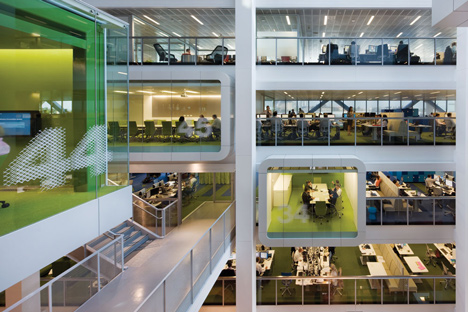
Claire Thomas: You trained as an architect. What got you interested particularly in inside spaces?
Clive Wilkinson: Life's a series of forked paths and you make choices without knowing what the ramifications are. When I got out of high school I wanted to write poetry - seriously, that was my life ambition. I wanted to go and do a literature course at Cambridge in England but my parents couldn't afford to send me so I ended up going to architecture school here, because my sister was in architecture school.
I'd heard all about the first year course, which was a real Bauhaus course, where you didn't actually design any buildings you did all these conceptual things like points and lines and space and sculptures. I thought it was mind liberating. I went into it not caring whether I passed or failed, and as a result I did better than anyone else because I was able to experiment and play, and not think about what the teachers wanted but do what interested me.
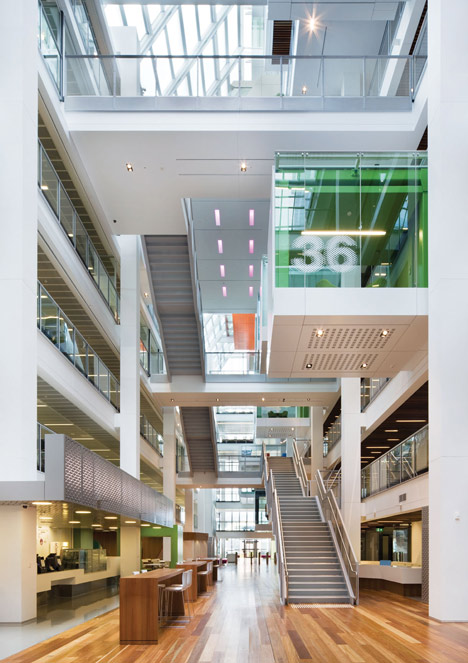
Claire Thomas: Is fearlessness also something you aim to bring out of people who use your workspace designs?
Clive Wilkinson: I think there's far too much fear in the world. Fear makes people sad and reluctant to do things, and it puts them mentally on a path of waiting for things to happen to them. In our design practice we are fundamentally trying to address psychological issues. One of the reasons I really like workplaces and interiors is that the impact on humanity is much more powerful than dealing with inert architectural shells, or the decorative outside dress of a building - which frankly is what most architects do. They don't really think about the insides any more; they're not asked to think about the insides any more because the content in the interiors of buildings has become banal. Interiors have become the element of human culture than you insert into the inert box of architecture.
Claire Thomas: What's behind this inertia?
Clive Wilkinson: It's driven by money. It's driven by developers and by the economics of cities. And you can't blame architects for that at all, it's market-based. There's a notion that you can't build big buildings for owners who have highly specific needs because needs change and therefore that building will be compromised by its specificity. So architects are placed in a market of building shells. That's very different to two hundred years ago when people could build gorgeous buildings that were highly specific but also very flexible.
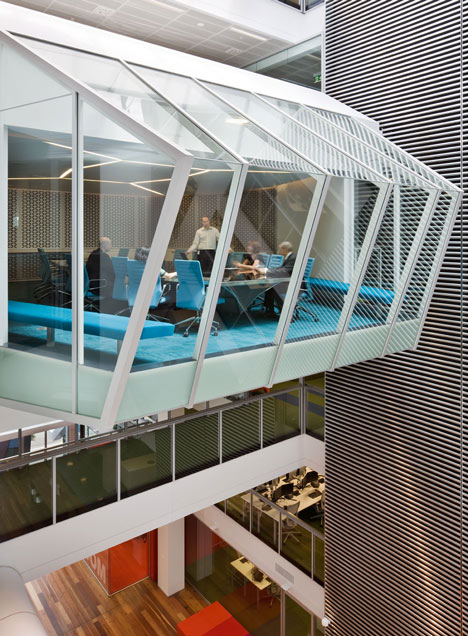
Claire Thomas: What is wrong with workspaces today?
Clive Wilkinson: There's an unfortunate dilemma that has occurred in the marketplace where people feel disconnected. Our clients are asking us to do things that are not healthy at all, part of a fear-based reaction to the alienating and disenfranchising accept of large corporate offices.
Claire Thomas: What's the worst example you've seen of that?
Clive Wilkinson: I don't think many people build bad examples any more, the general trend is to open up the workspace and increase accessibility and transparency, and choice and opportunity.
Claire Thomas: Lots of people still work in old un-refurbished offices.
Clive Wilkinson: Cubicles are the worst - like chicken farming. They are humiliating, disenfranchising and isolating. So many American corporations still have them. I'd say 75-80 percent of America is cubicle land. They still want six-feet-high panels around cubicles and I fight clients on this subject constantly because it is so stupid.
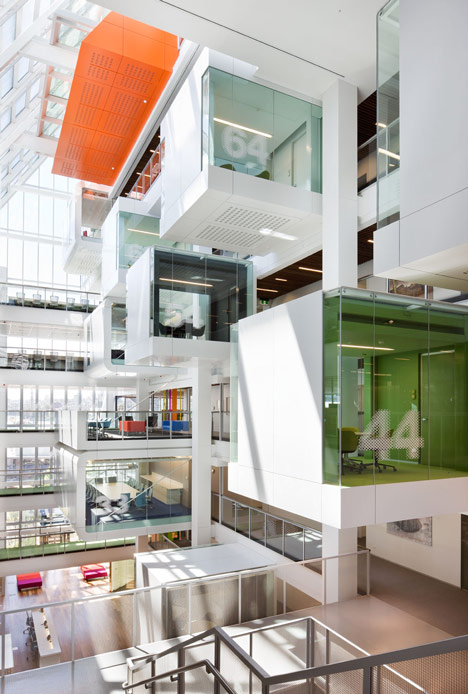
Claire Thomas: Who has horrible cubicles? Give us some names!
Clive Wilkinson: Google was cubicle land when we started working with them. We worked on the original Googleplex work space. We had to do quite a bit of convincing to make the founders move away from their cubicle model. We managed to turn all of their enclosed rooms into glass rooms. That led us to this interesting tent roof system that we used throughout their offices.
Claire Thomas: What's your view on glass as a material in offices? Everyone is glass crazy now but don't you want privacy at times when working?
Clive Wilkinson: We've had to walk the talk with what we do. I think there are simple behaviour changes that people need to go through to adapt to glass. I don't have any issue with being seen all the time. We built our own offices in LA and all our meeting room front walls are glass. I work on the same type of desk that every one else works on so everyone is connected in the same way as the very large desk we designed.
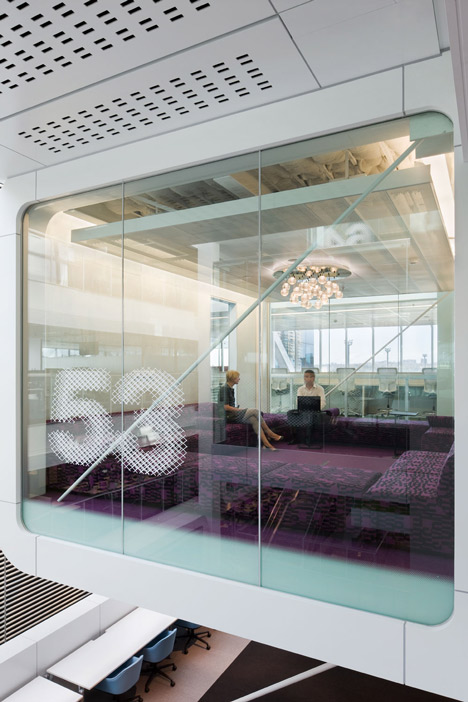
Claire Thomas: Open-plan, modular workspace with lots of glass seems to be the current accepted way to work. Where's office design going next?
Clive Wilkinson: Workplace culture can be supported in a very sophisticated way by work tools, and work settings that are customised to different kinds of work - both individual and collaborative. That's the future. It's not sunk home in America yet because American businesses are very conservative and issues of real estate don't tend to get the attention of the CEO. Conversely in Australia, where corporations are not that big, real estate does get the attention of the CEOs. They are mindful of the massive impact that an environment can have on productivity and effectiveness of the company and are prepared to take it pretty seriously.
What we did with Macquarie investment bank in 2009, using ABW, that's Activity Based Working, a highly supported way of mobile working, I was told by Macquarie people a year ago that pretty much every other major bank in Australia had picked up this way of working because it made sense to give people choice and liberating them from paper, and reducing carbon footprint. We might as well be in the future now.
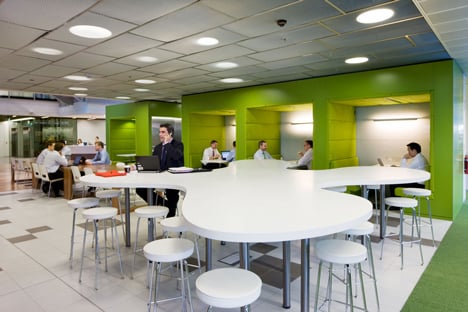
Claire Thomas: People are working form home more and using Skype and the web to connect. How long before offices are dead?
Clive Wilkinson: Truth is, we're not as virtually well connected as we think. The amount of information that's conveyed by looking people in the face and seeing their body language and seeing their eyes in person, hearing the tone of their voice and the subtleties of the communication, is enormous. By using something like Skype, the quantity of that information is reduced exponentially. You get 15 percent of the depth of that information. So coming face-to-face is never going to go away unless virtual devices take us there. But I don't think they will. You can't smell someone form across the street, you can't feel the space they're in, it might be colder where they are, you might misinterpret each other.
Claire Thomas: Which part of the world gets it right when it comes to using design to help people work better?
Clive Wilkinson: The San Francisco to Silicon Valley area of America is a massive test bed of new working but it's not completely radical yet. They still haven't gone completely mobile yet. The companies in that area are just phenomenally rich. Google, Apple, Yahoo and a stream of others - Airbnb, Skype, Twitter.
Claire Thomas: What do they all do right?
Clive Wilkinson: They all have to attract the same talent. One of the biggest motivators for creating good workspaces is being attractive to people you want to hire. There's a the amount of effort and energy being put into that. We're not involved but there's a huge amount of creative workspace being churned out.
